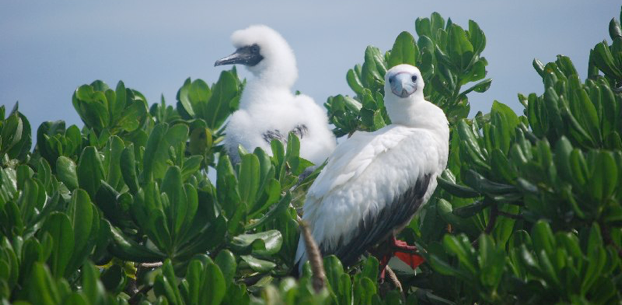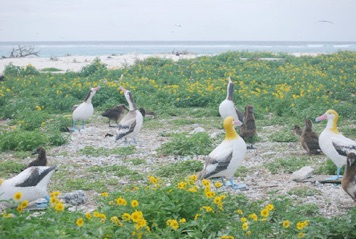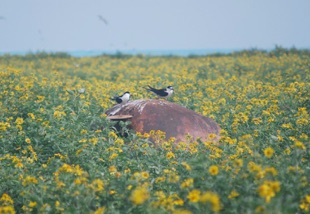Thursday, June 18, 2009


We headed across the channel this morning for a visit with the residents of Eastern Island (See map on June 7, 2009 blog entry). Eastern Island is home to 3 species of albatross (Laysan, Black-footed, and Short-tailed), 2 species of booby birds, including the masked bobby and the red-footed bobby (shown above with a chick), and numerous species of terns. Unlike the albatross and masked booby that nest on the ground, the red-footed booby nests in taller shrubs found on Eastern Island. As we walked along World War II runways overgrown with vegetation, we also discovered one of the experiments scientists are conducting on Eastern Island to try and encourage the endangered Short-tailed Albatross to return here for nesting. Decoys are being used with a solar-powered sound system to entice the birds to land here and begin their courting rituals (see video in the Midway Movie Gallery page). The scientists have had some initial and encouraging success with the decoys and currently project that they will have nesting pairs by next season.

The Battle of Midway took place primarily on Eastern Island and Matt Brown (US Fish & WIldlife Service) provided us with an overview of this historic event. Many of the relics left from the military era have been refurbished by resident plants and birds (see photo below). Before leaving Eastern Island, we waged a battle of our own as we worked to clean our shoes of the Tribulos plants (see photo below). These native plants have evolved spines as a transport mechanism to spread their seeds for reproduction.

REVIEW TOPIC: PLANT ADAPTATIONS
It is often easy to observe and understand the animal adaptations that help them to survive their environment. However, plants are living organisms “shaped by the world around them” and they must also adapt to survive and reproduce the next generation to avoid extinction. Thorns and spines are an adaptation that encourage an “easy ride” to the next island when the thorns attach to passersby, such as birds or humans. Look around your own neighborhood and observe various plant species to determine the adaptations that allow them to survive and reproduce. What adaptations can you observe? What are some forces that help to transport seeds across large areas? What other species might help to transport the seeds?

